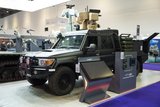Body Wearable Antennas to lighten load for soldiers
BAE Systems has developed a series of Body Wearable Antennas which will reduce the load that soldiers have to carry whilst providing them with a high level of battlefield information and connectivity.
The Body Wearable Antenna (BWA) allows soldiers to communicate with their colleagues on the front line without the need for conventional radio whip-antennas which can be cumbersome and conspicuous. By weaving the antennas into the fibres of the uniform the technology allows effective communication whilst helping improve agility. A concept demonstrator has been developed to showcase the capability of this technology which transmits voice, video data (from a helmet-mounted camera) and GPS location via the same antenna.
A system using this technology could improve the situational awareness of a military team as a whole, allowing soldiers to see through the eyes of their team mates in real time. If one soldier spots a situation, they can alert the team and share what they can see through their helmet mounted camera. The demonstration system links with a wrist-mounted commercially available touch screen smart phone and utilises its sensors to provide an augmented operational picture, allowing the team to tag objects, such as potential hazards which will appear highlighted on the phones video image.
Another major advantage of the wearable antenna system is that it is unaffected by the position of the wearer. With conventional whip-antenna systems, if a soldier has to lie on the ground, the communication between them and that of someone who is standing up can be severely compromised or even lost. Similarly, the signal from the short antenna on a portable radio can be masked by the user's body. A BWA system can be designed to give continuous 360° coverage.
Jon Pinto, Antennas and Electromagnetics Group Leader from BAE Systems Advanced Technology Centre said: "Frontline soldiers carry a huge amount of weight when on patrol. Research into body wearable antennas has shown we could reduce this burden and in the future give forces improved communication capabilities and a significant advantage on the battlefield"
The applications for this technology reach far beyond the defence industry. BAE Systems is currently exploring the potential to incorporate body worn antennas into the suits of fire-fighters for use during search and rescue, for police patrol team members to have the GPS locations of their colleagues and in other hazardous industries such as mining, oil and gas.
Source: BAE Systems
More from Digital Battlespace
-
![Babcock nears first customer for Nomad AI translation tool]()
Babcock nears first customer for Nomad AI translation tool
Nomad can provide militaries with real-time intelligence, saving critical time on the battlefield.
-
![AUSA 2025: Israel’s Asio Technologies to supply hundreds of improved Taurus tactical systems]()
AUSA 2025: Israel’s Asio Technologies to supply hundreds of improved Taurus tactical systems
Taurus operates alongside the Israel Defense Forces’ Orion system which supports mission management across tens of thousands of manoeuvring forces, from squad leaders to battalion commanders.
-
![AUSA 2025: Kopin pushes micro-LED plans as China moves faster]()
AUSA 2025: Kopin pushes micro-LED plans as China moves faster
The plan for the new displays follows fresh investment in Kopin’s European facilities by Theon and an order for head-up displays in fielded aircraft, with funding from the US Department of Defense.
-
![AUSA 2025: Persistent Systems to complete its largest order by year’s end]()
AUSA 2025: Persistent Systems to complete its largest order by year’s end
Persistent Systems received its largest ever single order for its MPU5 devices and other systems earlier this month and has already delivered the 50 units to the US Army’s 4th Infantry Division.
-
![Aselsan brings in dozens of companies and systems under the Steel Dome umbrella]()
Aselsan brings in dozens of companies and systems under the Steel Dome umbrella
Turkey has joined the family of countries attempting to establish a multilayered air defence system with government approval in August 2024 for the effort landed by Aselsan. Dubbed Steel Dome, the programme joins Israel’s Iron Dome, the US Golden Dome, India’s Mission Sudarshan Chakra and South Korea’s low-altitude missile defence system.
-
![DSEI 2025: MARSS unveils new agnostic multidomain C4 system]()
DSEI 2025: MARSS unveils new agnostic multidomain C4 system
MARSS’ NiDAR system has been deployed using sensors from static platforms to provide detection and protection for static sights, such as critical infrastructure, ports and military bases.




























